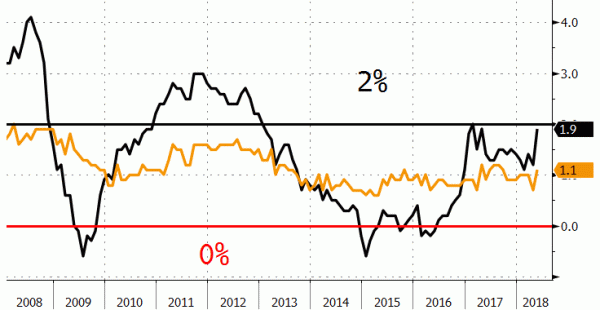- ECB orchestrated communication to build expectations
- Draghi to change forward guidance on APP: December 2018 firm end date
- Window of opportunity via higher inflation expectations
- Announcement should set a bottom below yields, euro to take the edge over USD
Expectations going into the previous, April, ECB meeting were low and President Draghi immediately took the sting out of the Q&A session by indicating that they didn’t discuss monetary policy. The Italian political crisis in the second half of May threatened to produce a similar outcome at this week’s ECB meeting if it wasn’t for last week’s orchestrated ECB interventions. A well‐placed and welltimed “sources” article reminded investors that the June policy meeting is a “live” one. That’s central bank lingo suggesting possible changes to communication/policy could be taken. Soft rumours rapidly turned into clearer and somewhat hawkish comments from the likes of ECB Praet, Weidmann, Knot and Hansson.
Chief economist Praet is one of the architects of the current exceptional monetary policy. He always defended the very accommodative policy by arguing that enough slack remains for the EMU economy to grow without creating inflationary pressures. Last week he changed course by pointing to increasing signals that inflation is converging towards the ECB’s 2% aim. He added that the central bank will have to assess on June 14 whether to signal an eventual end to the APP. The significance of what was a rare and specific hint from Praet shouldn’t be underestimated. Dutch central bank governor Knot added that it would be reasonable to announce the end of the net asset purchases soon. Bundesbank president Weidmann, another heavyweight, said that market expectations of an end to QE this year are plausible. Estonia’s central‐bank governor Hansson suggested that official interest rates might even climb sooner than investors expect.
Tapering in Q4 2018
Aggregating last week’s ECB rhetoric suggests at the very least a preannouncement this week about the future of APP even if specific details of the ending of the programme might not fully emerge until in the following council meeting in late July. However, we think that, on balance, recent comments in the media mean risks have shifted to the point where markets will expect a clear communication outlining the ECB’s future intentions in regard to QE on Thursday. The most plausible explanation for the ECB’s encouragement of such expectations is that it wants to eliminate any room for ‘event risk’ to pop up and map out 2018 monetary policy as soon as possible.
More specifically, we think Draghi may announce that the ECB will taper its asset purchases by €10bn/month to conclude the programme by December 2018. The forward guidance currently reads that net asset purchases are intended to continue at a monthly pace of €30bn until the end of September, or beyond, if necessary, and in any case until the Governing Council sees a sustained adjustment in the path of inflation consistent with its inflation aim. Praet’s comments suggest that this final condition has now been met.
The latest EMU inflation numbers create a window of opportunity for the ECB to finally take the next step in its normalization process. Preliminary estimates for May show that headline inflation jumped from 1.2% Y/Y to 1.9% Y/Y and core inflation picked up from 0.7% Y/Y and 1.1% Y/Y. Seasonal factors and the rise in energy prices are significantly responsible for what appears to be a notable change in trend. The numbers will probably remain elevated, at least for the next two months. While the ECB won’t let itself be unduly swayed by unusual and possibly reversible movements in monthly inflation data , it will be interesting to see if the May figures are seen as indicative of a long expected firming in inflation. If this is the case, it could prompt upward revisions to new inflation forecasts which the ECB will release on Thursday. March projections showed an average 1.4% inflation rate both this year and next and 1.7% in 2020. The ECB assumed an average oil price of $65/barrel and a spot rate of 1.23 for EUR/USD. Updates to both imply higher inflation, at least for this year. Praet’s hint about building underlying inflation pressures could translate into a crucial upgrade of the 2020 forecast which would underpin a decision to end the asset purchase programme
Growth forecasts amounted to 2.4% in 2018, 1.9% in 2019 and 1.7% in 2020. The disappointing Q1 GDP print suggests a downward revision for this year. The KBC forecast for 2018 is 2.1%. We don’t think that the ECB will move too quickly or aggressively to downgrade its 2019 and 2020 forecasts although a slight pull‐back could be the counterpoint to a slightly higher inflation forecast. The ECB is clearly focused on the potential negative impact from the escalating trade war, but may appear as a significant downside risk in the balance of risks rather than as a key element of the central scenario.
The continuous decline in the EMU composite PMI, from a cycle high of 58.8 in January to 54.1 in May is partially because of a natural rolling over and partially because of stress‐related to eg the trade conflict and the Italian crisis
However, the absolute level of the PMI at present remains consistent with a very healthy pace of growth in the Euro area, giving the ECB leeway to pursue a very gradual normalization process.
The forward guidance on interest rates and QE reinvestments are both likely to remain unchanged. The ECB may want to signal that a journey out of unconventional policy is about to begin, but the pace of travel is unlikely to be speedy. The ECB at this stage doesn’t want to trigger early rate hike expectations. We do agree with ECB Hansson though that current expectations about a first rate hike (end 2019) are too dovish. We eye a first deposit rate increase by mid‐2019. The reinvestment policy is expected to remain in place in the foreseeable future
Higher EMU yields and stronger euro?
If the ECB provides clear signals on Thursday of its intent to end QE, it will want to sugar coat this pill. So, Mr Draghi will likely emphasize that monetary policy will remain very accommodative. However, an ECB announcement about an end date of APP would be a significant development and should soon put a firm bottom below European interest rates. The German 10‐yr yield could return above the 0.5% mark and thereafter proceed initially towards a test of this year’s high around 0.8%. In Q4 2018, interest rate expectations will start to build whether the ECB wants it or not. The next significant move of the ECB, changing forward guidance on interest rates, could come at the December meeting. The ECB meeting coincides with the Fed meeting this week with the US central banks expected to hike its policy rate by 25 bps to 1.75%‐2% with a potential hawkish shift in the dots. The US side of the story is more discounted than the European one, suggesting that the balance could shift in favour of the single currency on FX markets. First resistance in EUR/USD stands around 1.1830













